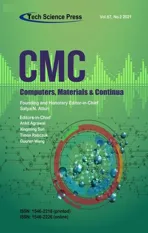Optimized Predictive Framework for Healthcare Through Deep Learning
2021-12-16YasirShahzadHumaJavedHaleemFarmanJamilAhmadBilalJanandAbdelmohsenNassani
Yasir Shahzad,Huma Javed,Haleem Farman,Jamil Ahmad,Bilal Jan and Abdelmohsen A.Nassani
1Department of Computer Science,University of Peshawar,Peshawar,25120,Pakistan
2Department of Computer Science,Islamia College Peshawar,Peshawar,25120,Pakistan
3Department of Computer Science,FATA University,Kohat,26100,Pakistan
4Department of Management,College of Business Administration,King Saud University,Riyadh,Saudi Arabia
Abstract:Smart healthcare integrates an advanced wave of information technology using smart devices to collect health-related medical science data.Such data usually exist in unstructured,noisy,incomplete,and heterogeneous forms.Annotating these limitations remains an open challenge in deep learning to classify health conditions.In this paper,a long short-term memory (LSTM)based health condition prediction framework is proposed to rectify imbalanced and noisy data and transform it into a useful form to predict accurate health conditions.The imbalanced and scarce data is normalized through coding to gain consistency for accurate results using synthetic minority oversampling technique.The proposed model is optimized and fine-tuned in an end to end manner to select ideal parameters using tree parzen estimator to build a probabilistic model.The patient’s medication is pigeonholed to plot the diabetic condition’s risk factor through an algorithm to classify blood glucose metrics using a modern surveillance error grid method.The proposed model can efficiently train,validate,and test noisy data by obtaining consistent results around 90% over the state of the art machine and deep learning techniques and overcoming the insufficiency in training data through transfer learning.The overall results of the proposed model are further tested with secondary datasets to verify model sustainability.
Keywords:Recurrent neural network;long short-term memory;deep learning;Bayesian optimization;surveillance error grid;hyperparameter
1 Introduction
Advanced healthcare is an open technological facet providing multidisciplinary telemedicine treatments from basic sprains to complex chronic disease at the industry level.The vast range of eHealth innovations and applications such as interactive websites,web-portals,telehealth,e-mail,voice recognition,online health groups,and gaming are swiftly challenging the old conventional approaches [1].The healthcare industry has tailored large scale interventions to provide affordable medical clarity through fast,reliable,robust,and recursive diagnostic techniques.Smart healthcare,therefore,falls under vertical industry areas such as very large-scale integrations,embedded systems,big data,cloud computing,and machine learning (ML) [2].
In addition to its vast scope,little attention is paid to data variance,noise,broad and scarce data in the literature.Deep learning (DL) is often rarely used with transfer learning (TL) for health related conditions.The current research proposals are consistent with ML conventional approaches,simple datasets,long delays,and open-loop problems,particularly with regard to control algorithms [3].Subsequently,data normalization is either done manually or through conventional approaches,and nonlinear regression models are used through linear and dynamic approaches.Nevertheless,neural networks are ideal for modelling blood glucose levels using multilayer perceptrons and generative architecture DL techniques [4].The discriminant architecture of DL embedded into TL is currently infrequent to find,especially for a diabetes prognosis.This research focuses on predicting health related issues and conditions such as diabetes and its associated diseases.
Diabetes Mellitus (DM),a dreadful disease,has affected one out of eleven adult populations globally,and up till now,it is not treated seriously.World Health Organization (WHO) depicts that the alarming figure of 463 m may rise to 578 m by 2030 and 700 m by 2045.The WHO cautions that such huge figures bring a direct financial global impact to 760b in 2019 to 823b by 2030 and 845b in 2045.Moreover,232 m people live with this infection in undiagnosed form and have so far caused 4.2 m global deaths making it a fourth major mortality epidemic disease.Diabetes invites diverse effects on children and adults’ health,such as renal dysfunctions,cardiovascular,neuropathy,micro/macrovascular diseases,retinopathy,gums,dental,sexual,bladder,and vessels [5].There are three different known diabetes BG states such as normal state between 80 to 130 mg/dL,hypoglycemia below 80 mg/dL,and hyperglycemia above 180 mg/dL [6].Common symptoms of both hyperglycemia and hypoglycemia are shown in Fig.1.
In this research,we present a complete framework by proposing a recurrent neural network(RNN) based long short-term memory (LSTM) model to predict the patient’s past,present,and future sickness status.The proposed model has been tested for the challenging and noisy dataset(dataset-I),which is normalized to find suitable parameters for high accuracy using advanced optimization and hyperparameter (HPM) tuning.The results obtained are assessed by a surveillance error grid (SEG) to chalk out blood glucose (BG) metric.Two secondary datasets have also been trained and tested to validate the results by comparing with state of the art ML and DL techniques.We contribute to:
• Improve the accuracy rate of the predictive model and making it suitable for arbitrary nature datasets.
• Use pre-processing procedures to find fine-tuned and optimal weights for accurate results.
• Propose an easy method to train challenging data by feature engineering to increase prediction accuracy.
• Design a model that efficiently predicts illness status from the past,present,and future data relating to medication categorization,normalization,hyperparameter tuning,and accurate prediction.
The rest of the paper is organized in the following manner.Section 2 gives a recent literature review with its limitations.Section 3 has a complete methodology approach.Section 4 gives results and discussion.Finally,Section 5 concludes with future directions and limitations of this research.
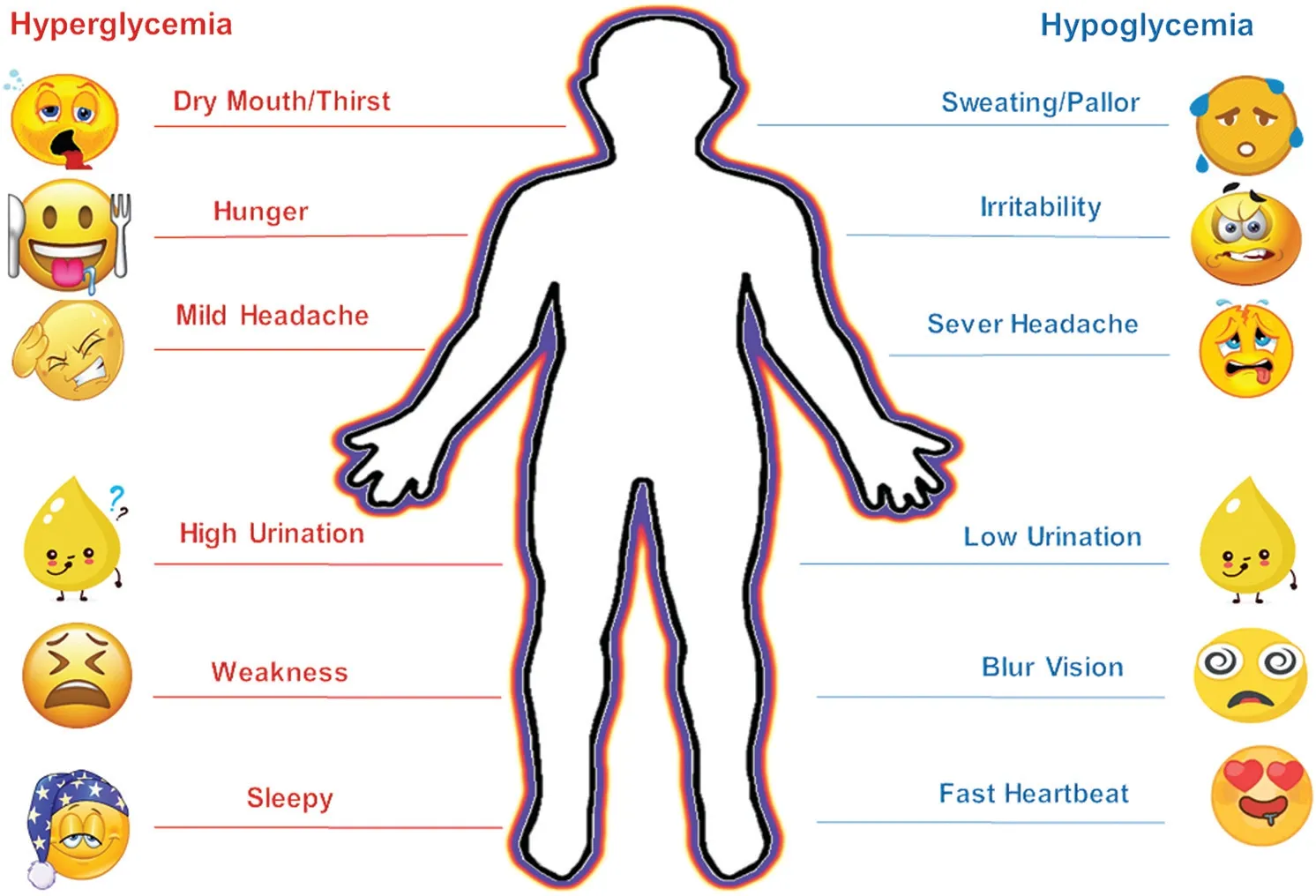
Figure 1:Common glycemic symptoms
2 Literature Review
Despite many efforts and achievements in the health industry,clean digital medical data remains an important and difficult challenge to obtain.Predicting accurate and productive risk factor has always been an important subject attracting many researchers’ interests.The relevant topical work is discussed below.
The authors in [7]proposed an artificial neural network (ANN) using the backpropagation and apriori algorithm to detect diabetes.An online manual system exploiting chain rule for frequent mining itemsets is proposed to detect diabetes condition.However,besides manual inputs,a simple dataset is tested to negate the involvement of doctors.No data normalization,BG metric,and TL are observed.An advanced approach is seen in [8]by proposing a DL restricted Boltzmann machine based framework to detect diabetes.The proposed work can differentiate between Type-I and Type-II diabetes by classification and recognition using decision tree ML method.Their proposed model is manual and independent between layers using a likelihood approach.However,data is input through top-down feedback with low performance and high time complexity.Three hundred data samples are selected with no clear picture of the source.Additionally,data scarcity and imbalances are not addressed.No BG metric and TL are observed.
The authors in [9]proposed a DL approach,namely GRU-D,to recover missing data for successful imputation and improved prediction.Gated recurrent unit,GRU-D is built using RNN to exploit masking and time interval in two representations of missing patterns and incorporate deep model architecture.Missing values are estimated to achieve prediction results.However,MIMIC-III dataset is selected for research with no diabetes taxonomy and cataloging,TL,and grid classification.Collaborative filtering-enhanced DL (CFDL) is proposed by [10]to build a reference system to predict future based behavior patterns.The model finds an incomplete input to predict patient readmission.However,data incompleteness and noise are addressed by ML using a traditional normalization approach.Also,no BG metric and TL are observed.
The authors in [11]proposed a model to utilize distributed and parallel computation using multiple GPU’s through DL.A large dataset of Type-2 DM is used to observe hardware and software computation complexity.However,no data optimization,categorization,TL,and error grid is seen.Decent research is observed in [12],where the authors offered RNN based LSTM with embedded TL.A Gaussian kernel is exploited using six-month continuous glucose monitoring(CGM) data of 26 participants.However,the dataset is small,and also,the error grid approach is outdated,and diabetes categorization is not observed.Another decent work is observed in [13],where authors used RNN based LSTM to estimate BG level using root mean square error(RMSE) and univariate Gaussian distribution over the output.Future forecasting is done by using the history of BG levels.However,the proposed research uses a single dataset with no trace of TL and diabetes medication categorization.
3 Methodology
Machine learning entails high-quality training that directly depends on the quality of input data,which is not easy.The accuracy of such data can be regulated by deriving a training dataset (to predict model),test dataset (to determine the future performance of the predictive model),and validation dataset (to measure the predictive model’s adherence to a given quality standard).Healthcare is essential for the growth of many benevolence opportunities,computing fields,strength,and confidence in the health sector’s outcomes.Nevertheless,a dataset format should retain the structure and individual values in syntactic integrity so that a health practitioner may practice automated analysis.
3.1 Dataset
Over twenty datasets of diabetes and their associated disease are downloaded,discussed,evaluated,and analyzed.Three datasets from the UCI ML repository are selected;a primary dataset (Dataset-1) [14]and two secondary datasets (Dataset-2,Dataset-3) [15].The challenging and noisy dataset-I is grouped into medicinal,peculiar information,and diagnoses with a total of 101,766 instances and 50 attributes,including 47,055 male,54,708 females,and 3 unknown genders.Simultaneously,the attributes of secondary datasets are grouped into personal information,medical tests,and keystone habits.
The primary dataset requires a detailed transformation to invoke DL abilities because insufficient information leads to inefficient models.The dataset-1 features are grouped into three categories such as patient demographic information (race,gender,age,weight,etc.),hospital metrics (number of procedures,insulin levels,number of lab procedures,H1A1c test,etc.),and diabetes medication (metformin,repaglinide,glimepiride,chlorpropamide,etc.).The extracted information and correlation between attributes are given in Fig.2.The primary dataset contains errors,missing values,and anomalies.Preprocessing is required to gain consistency in data to prevent overfitting.The sparse properties are eliminated by auto-normalization as most fields do not have usable values,and little predictive information,as shown in Fig.3.
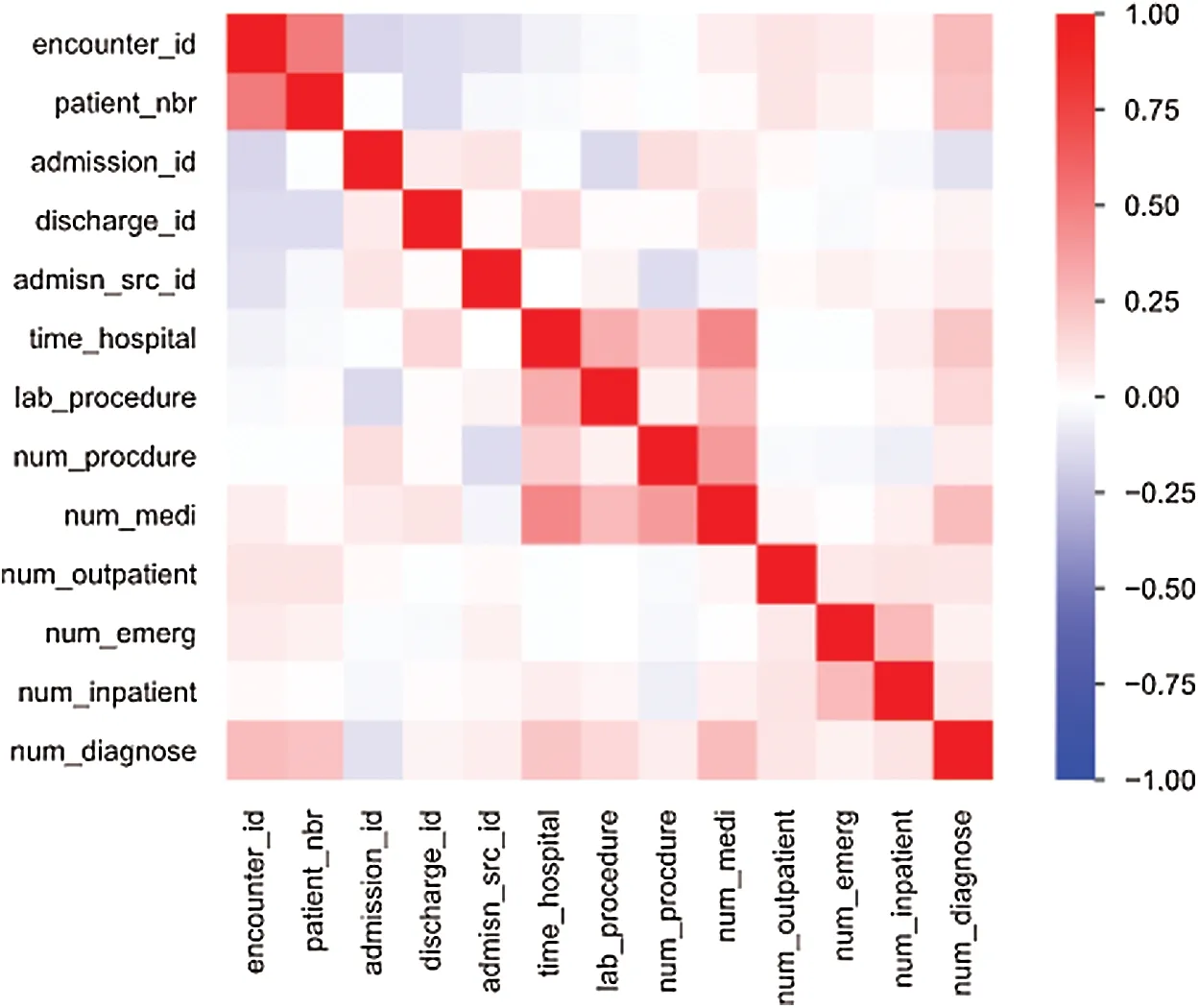
Figure 2:Pearson’s correlation coefficient (r) heatmap shows a high relationship between encounter_id and patient_nbr,time_hospital with num_medi and lab_procedure,and num_procedure with num_medi
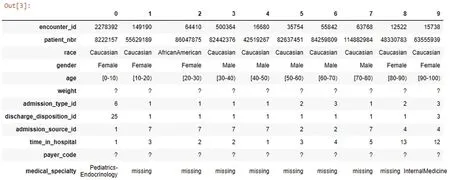
Figure 3:Weight,payer_code,and medical_specialty have high missing values
3.2 Imbalanced and Missing Values
Imbalanced data usually arise when the data is dominated by a majority class and ignoring a minority class.Hence,the dataset-I classifier routine on the minority is insufficient compared to the majority.To deal with such imbalanced data,either use the under-sampling method to balance the class and eliminate some portion of the majority class or use synthetic minority methods to increase the number of minority class instances.Synthetic minority oversampling technique (SMOTE) is preferred to create new instances rather than replicating the existing [16].In the selected dataset,attributes having more than 50% missing values are dropped because of no significance in filling those values,as shown in Fig.3.
3.3 Value Mapping
Data transformation is performed to find and map useful informationf:Rn→R in the form of [0,1],as shown in Tab.1.Theagevariable is defined by mean age interval and translated to a numeric value.

Table 1:Value mapping in dataset-I
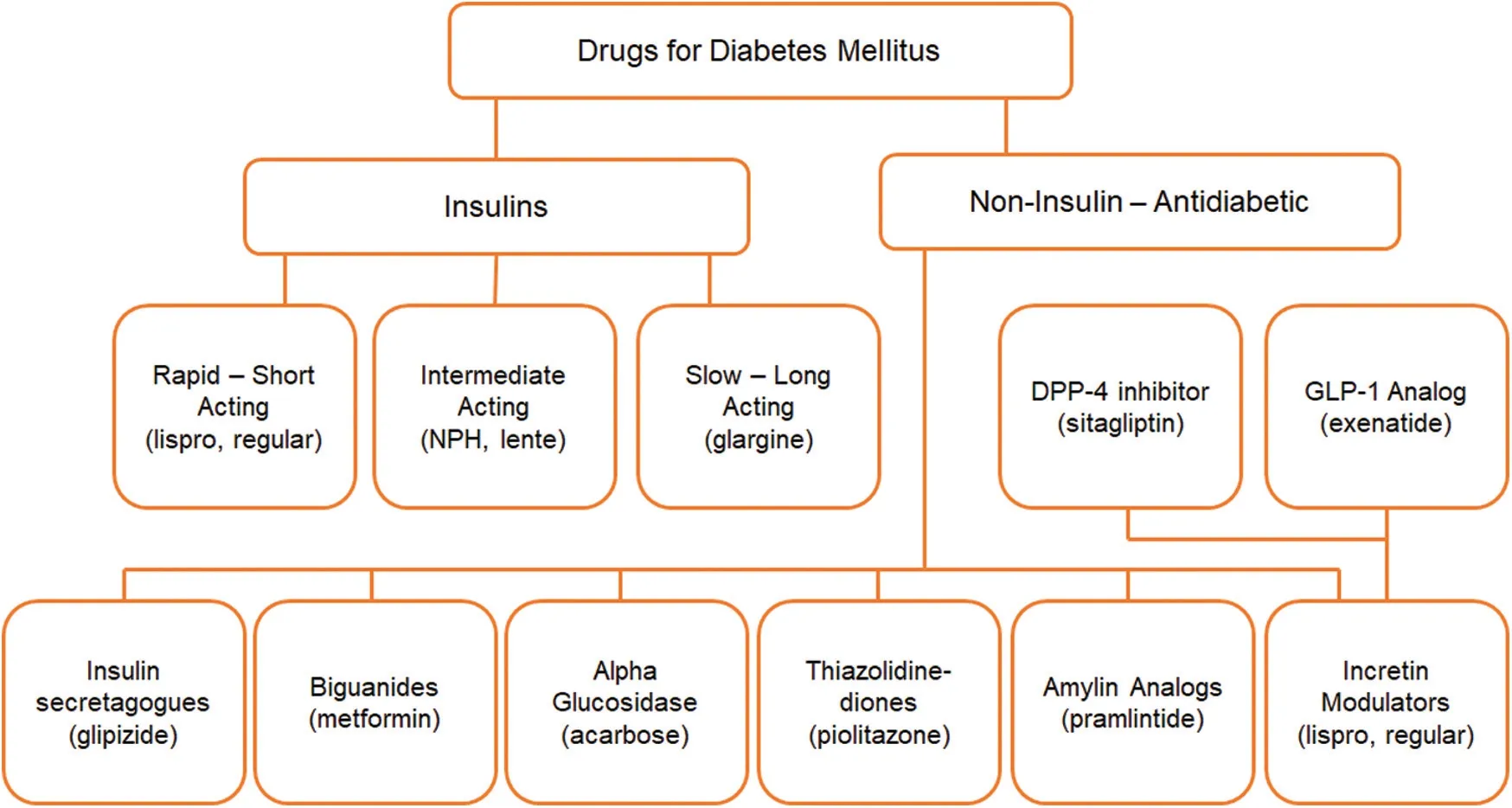
Figure 4:Diabetes medication in their standard class
3.4 Proposed Algorithm
The primary dataset includes twenty-three different medicines,which is ordered into medicinal class,as shown in Fig.4.The categorization and classification are being carried out in consultation with medical specialists and endocrinologists for diabetic culture,current treatment trends,and diabetes medicinal groups.
The training of a model requires a complete classification of administered medicine at home and during the hospital visit.The drug intake is added into the model,as illustrated in Algorithm 1.
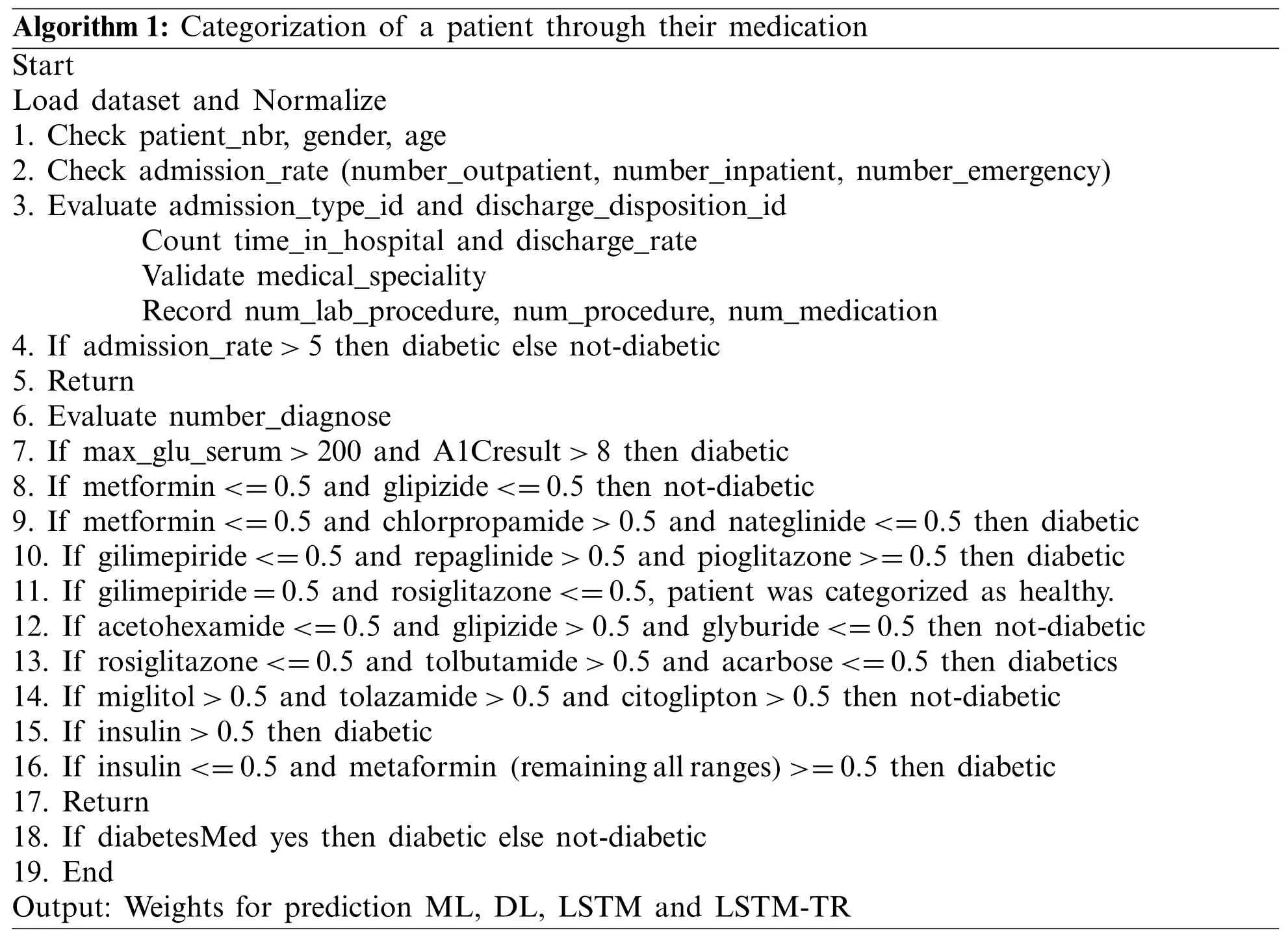
Algorithm 1:Categorization of a patient through their medication Start Load dataset and Normalize 1.Check patient_nbr,gender,age 2.Check admission_rate (number_outpatient,number_inpatient,number_emergency)3.Evaluate admission_type_id and discharge_disposition_id Count time_in_hospital and discharge_rate Validate medical_speciality Record num_lab_procedure,num_procedure,num_medication 4.If admission_rate>5 then diabetic else not-diabetic 5.Return 6.Evaluate number_diagnose 7.If max_glu_serum>200 and A1Cresult>8 then diabetic 8.If metformin<=0.5 and glipizide<=0.5 then not-diabetic 9.If metformin<=0.5 and chlorpropamide>0.5 and nateglinide<=0.5 then diabetic 10.If gilimepiride<=0.5 and repaglinide>0.5 and pioglitazone>=0.5 then diabetic 11.If gilimepiride=0.5 and rosiglitazone<=0.5,patient was categorized as healthy.12.If acetohexamide<=0.5 and glipizide>0.5 and glyburide<=0.5 then not-diabetic 13.If rosiglitazone<=0.5 and tolbutamide>0.5 and acarbose<=0.5 then diabetics 14.If miglitol>0.5 and tolazamide>0.5 and citoglipton>0.5 then not-diabetic 15.If insulin>0.5 then diabetic 16.If insulin<=0.5 and metaformin (remaining all ranges)>=0.5 then diabetic 17.Return 18.If diabetesMed yes then diabetic else not-diabetic 19.End Output:Weights for prediction ML,DL,LSTM and LSTM-TR
3.5 Data Normalization
The dataset value range fluctuates widely.Thus,the learning algorithm’s output can be dominated by features with higher values within a predefined limit (say Optimal Range) to retain inherent details.The Optimal Range (OR) is a set of patterns used to predict the next sequence.Min-max normalization is used to permit a configurable range to scale values in the datasets,as depicted in Eqs.(1) and (2).


whereXNoris the initial value feature interest,XMinshows minimum value,XMaxis a maximum value,andRdenotes the optimal scaled features set [−1,1].To generalize the whole procedure,consider OR=4 sayp1,p2,p3,p4to predict valuerofp5with unitsQ1,Q2,Q3.The first moduleQ1takes the input vectorp1,p2,p3,...,pORand the second moduleQ2takes the input vectorp1,p2,p3,...,pORwith output of first module,and so on.The final module (Q3) will predict the valuerOR+3,as given in Eq.(3).

HereNis the total number of samples for time instancei·andyiare the predicted and actual values.To offer perception about the working of RNN,the network typically gross an independent variable(s) X and a dependent variable y followed by the mapping and training between both X and y.The process sequence of values are(X1,X2,X3,...,Xt+1,Xt,Xt−1).So,Xthas a sequence of data at timetand parameter stateΘ,which is equal toxt=Statextis dependent on the input parameterXt−1,which is a previous timestamp of the model,as shown in the process model in Fig.5.

Figure 5:Overall proposed RNN-LSTM model with TL
3.6 Model Classification and Tuning
RNN is a linear memory architecture that maintains all previous information in the internal state vector.Gradient approaches may fail when time dependencies become too long due to exponential increase or decrease in values [17].RNN suffers from gradient vanishing,exploding,challenging training,and treating long sequencing.LSTM resolve RNN long-term dependency problem by maintaining relevant information for more extended periods and forgetting irrelevant information.LSTM also overcomes the back-flow error problems and process large datasets by keeping the cell’s information through structural gates.The proposed model uses three distinct gates;forget gate,input gate,and output gate,as shown in Eqs.(4)-(6).The forget gate is responsible for deciding which input information from previous memory may be ignored.The input gate is responsible for feeding certain cell information.The output gate generates and updates the hidden vector.Additionally,LSTM allows a fourth gate called Input Modulation Gate,a subpart of the input gate,to reduce the learning time as a Zero-Mean for faster convergence,as shown in Eq.(7).The input gate exploits feedback weights from other memory cells in order to store or access data on its memory cell.

whereσis a logistic sigmoid function to decide among [0,1]values to let it through,k is recurrent weight,m is input weight,and b is bias value.The obtained feeding back performance of LSTM is a layer at timetto the input of the same network layer at timet−1.The complete process is shown in a block diagram in Fig.6,where information regulates using control gateskg,kfandkoby internal state ‘c.’

Figure 6:LSTM vector ‘x’ (The Past) a single input to predict an output ‘y’ (The Future)
3.7 Hyperparameter Optimization
Selecting ideal parameters is the key difference between average and state-of-the-art performance in a neural network because an algorithm highly depends on HPM.Various aspects,such as memory utilization and computation complexity,depend on HPM tuning,which requires more training time for significant results.HPM optimization is defined as in Eq.(8).

Herex∗is the minimum generated score value,mx∈Xshows thatxcan assume any value in the domainXandf(x)indicates the target score to reduce the validation set error.The overall goal is to evaluate model HPM producing a high score on the validation set metric.Tuning of ML algorithms is subject to trials and errors to find the optimal values,which could be either done manually or automatically.For the purpose,an automated method such as Bayesian optimization is designated to systematize finding HPM in less time using an informed search technique and assess values based on past trials.Bayesian optimization is a famous,simple,and collective approach in DL to sequentially optimize an unlabeled objective function.Bayesian’s method selection is preferred over random search optimization because the latter use long run times to assess doubtful areas of the search space [18].Bayesian optimization allows fewer iterations to achieve excellent performance by tuning the HPM on building,training,and validating versions.Bayesian optimization is defined as in Eq.(9).

Our proposed approach use three HPM such as dropout,number of LSTM neurons,and network layer neurons.The parameter domain is defined using thehyperoptdistribution function [19].Hyperopthelps serial and parallel optimization over awkward search spaces,including real-valued,discrete,and conditional dimensions.To achieve consistenthyperoptfunction results,we feed input parameters to put forward to the objective function based on the Surrogate model engineering functionp(b|a).The surrogate act as an approximator of the objective function to propose parameter using tree parzen estimator (TPE),Gaussian process aka GPyOpt,or random forest regression through sequential model-based algorithm configuration (SMAC).In this research,TPE is preferred over the others to build a probabilistic model of the function at each step and choose the most likewise parameters.The complete framework of the operation model,including the Bayesian optimization process,is shown in Fig.7.
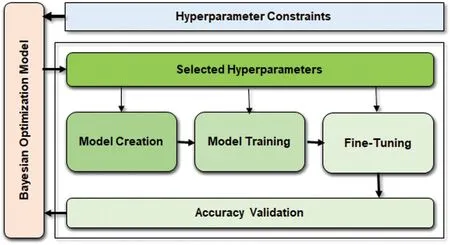
Figure 7:Bayesian optimization works on top of the predictive model to fine-tune HPM and validate accuracy.However,the weights are chosen from the HPM constraint block based on the values collected from accuracy validation
The algorithm creates a random starting point x∗and calculates F(x∗).It uses trial history for conditional probability model P(F|x).Select xi giving P(F|x),resulting in better F(xi).Calculate the real value of the F(xi) and repeat steps 3 to 5 till one of the stop criteria is satisfied,for instance,i>max_eva.TPE put forward HPM by applying surrogate and selection functions.Both combine to evaluate parameters that it believes bring/calculate high accuracy on the objective function.The selection function cum TPE-Surrogate is illustrated in Eq.(10) [20].Optimization results of LGBMRegressor,Grid Search,Random Search,and Hpyeropt optimization results are given in Tab.2,and their comparison is given in Fig.8.


Table 2:Comparison of search methods
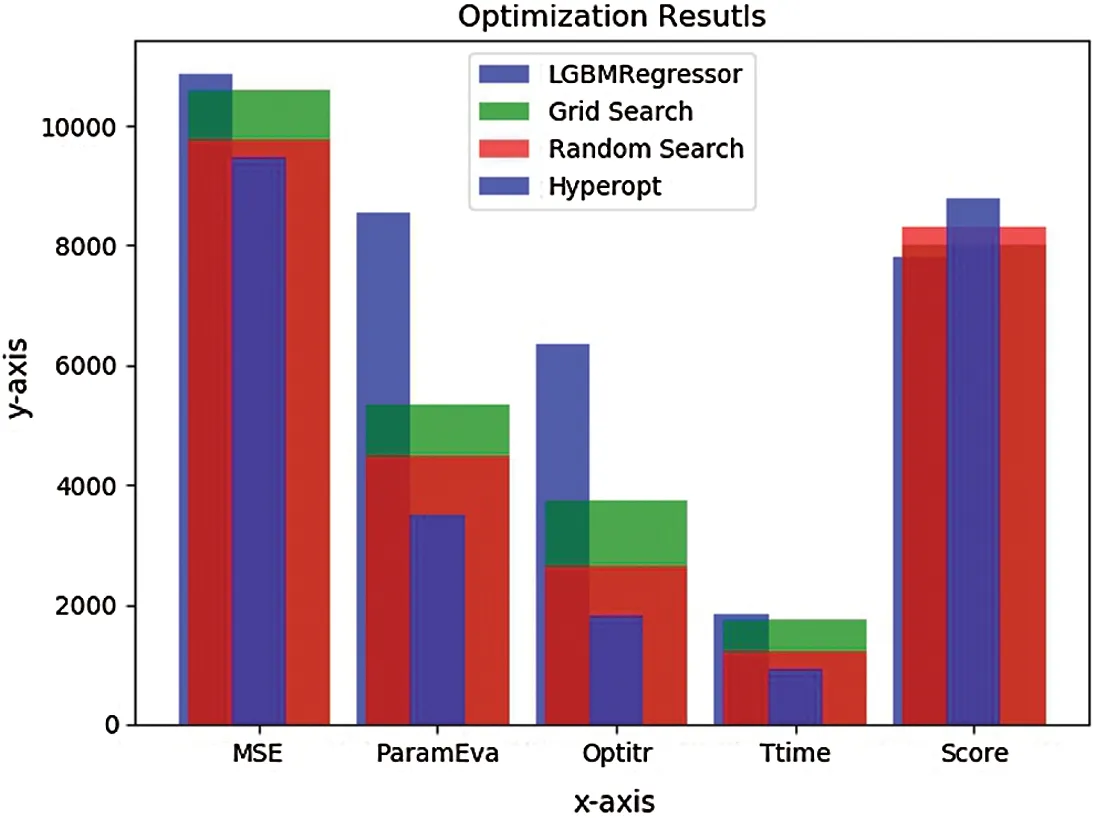
Figure 8:Optimization bar chart.The test score1=10,000
3.8 LSTM Output
LSTM can bridge time intervals and approximate noisy data to generalize over problem domains,distributed representations,and continuous values.It overcomes error back-flow problems to ensure neither exploding nor vanishing using specialized units’ internal state to reduce the input/output weight conflict.LSTM layer accompanies a dropout layer to prevent overfitting and a selected number of neurons for optimal training.In this research,the LSTM network has 512 hidden neurons and 256 neurons with an imposed dropout rate of 0.2 and 0.3 to refrain the model from over-fitting.The optimized input HPM is evaluated for 43 iterations until no improvements are seen.The output performance metrics considered are accuracy,precision,and recall to track LSTM predictive response as defined in Eqs.(11)-(13).

4 Results and Discussion
This research aims to build an optimized and user-friendly system that can process challenging datasets with dependent and independent variables.The optimization in autonomous mode dig deeper and draw optimal HPM for higher accuracy.More than twenty diabetes datasets are downloaded from the UCI repository having a variety of information,among which three datasets associated with each other are selected.The primary dataset is very challenging due to variation,noisy and incomplete data.To comply with data performance and accuracy,we test state of the art ML methods,as shown in Figs.11-13.We also define two DL testing and validation methods based on straight LSTM and embedded LSTM Transfer Learning (LSTM-TL).
The RNN based LSTM is preferred because it is capable of giving more control-ability and better results.It uses extended,long multiple and parallel sequences to produce accurate results on the dataset by learning and remembering input from direct raw time series data.Additionally,43 random seeds are trained for each HPM between 512 and 256 LSTM units;however,we went with 256 units to lower the complexity.The reason is that LSTM is a process hungry and time-consuming technique that requires error and trial approach for best suitable inputs.The proposed model is initially validated to 512 LSTM units,which consume extra operating cost and time.However,it is later on limited to 256 units for low complexity and processing.Moreover,the nature of datasets has a significant role in model performance by digging the valid inputs for dataset-I,whereas dataset-II and dataset-III are comparatively straight forward with low complexity,processing time,and operating cost.
4.1 Surveillance Error Grid
An evaluation standard is required to define the role of the proposed model for medical practitioners.To quantify patients’ clinical accuracy,few error grid analyses are used to edge the threat of indecent future forecasts of the monitored BG levels.Previously,clarke error grid (CEG)was a standard,famous,and old technique to evaluate BG levels in clinical practices.However,it faces limitations of (i) Lack of difference between type-1 and type-2 diabetes,(ii) Discontinuous transition between Zone-B and Zone-E,and (iii) A small number of diabetes experts introduced it.A successor,namely parkes error grid (PEG),is introduced to chalk out risk zones and declare thresholds for both types of diabetes.However,PEG has no integration to the smart technology and has required a vital need to review the odd approaches w.r.t.Type-1 patient insulin pump therapy,Type-2 insulin injections,and CGM insulin injections.Henceforth,it leads us to surveillance error grid (SEG) [21].The bilinear interpolation criterion of SEG is given as under [13].


Table 3:Risk grade of evaluated samples in light of SEG
The risk factor in above mentioned table is the difference between BGM and REF as percent of REF>100 mg/dL and in mg/dL for REF<=100 mg/dL.The distribution of dataset samples that lie in various zones of the SEG plot is shown in Fig.9.
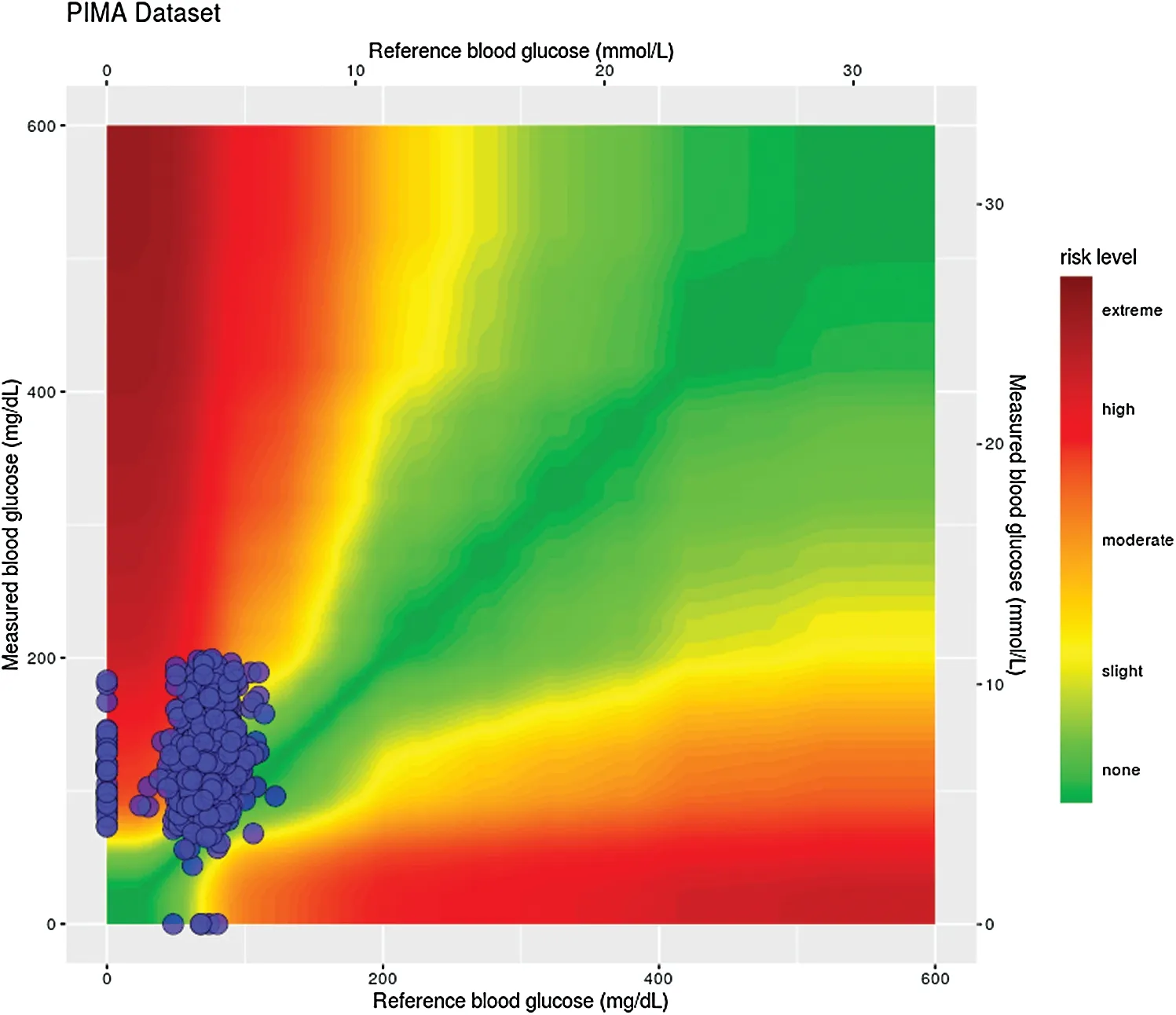
Figure 9:SEG plot showing sample risk factor
4.2 Performance Evaluation
DL is a data-hungry technique to understand the hidden data patterns,resulting in high data dependency.The scale and size of a data model are in a linear relationship that shows the model’s expressive space is large enough to discover the hidden patterns under the data [22].The proposed model performed well by a margin of significance with three input dimensions of samples,time steps,and features.An acceptable error tolerance threshold is obvious to iterate the model to reach convergence until no further improvement is seen.A 40-epochs stoppage policy is assigned to stop the validation process if no improvement is observed.Complete details of the LSTM model is given in Fig.10.

Figure 10:Param (total trainable:367,585,non-trainable:0)
The batch-size of LSTM output (batch-size,timespan,input) plays a vital role with a learning rate.The batch-size gradually enhanced from 128 to 768 for accurate results.The dataset distribution is set up to 60% for final training,20% testing,and 20% validation.A maximum of 5000 epochs and 500 enforced stoppage epochs are endorsed if no improvement is observed.In order to reuse the pre-trained data on imbalanced datasets,TL is used to fit a previously unseen dataset.
The transfer learning takes up a model trained data and utilizes it on a second related task,saving time and gives better performance.TL recovers an imbalanced dataset to eliminate classification problems where several observations per class are not equally distributed.TL takes the previously trained model and freezes them.It adds additional training layers to the top of the frozen layers and trains the final model.In other words,it allows the freedom not to train the model in a target domain from scratch,which significantly lessens the demand for training data and training time [22].However,gaps in the data lead to missing predictions.Therefore,to fill the missing values,it is not clear how much bias it would introduce.So,we propose to create the(a,b)pairs with a given historyaand regression targetbfor a given prediction horizon.The proposed approach help to train and predict utilizing maximum data.Performance evaluation for this research is based on accuracy,area under the curve (AUC),and recall metrics,whereas precision is a supporting metric as illustrated in Figs.11-13,respectively.
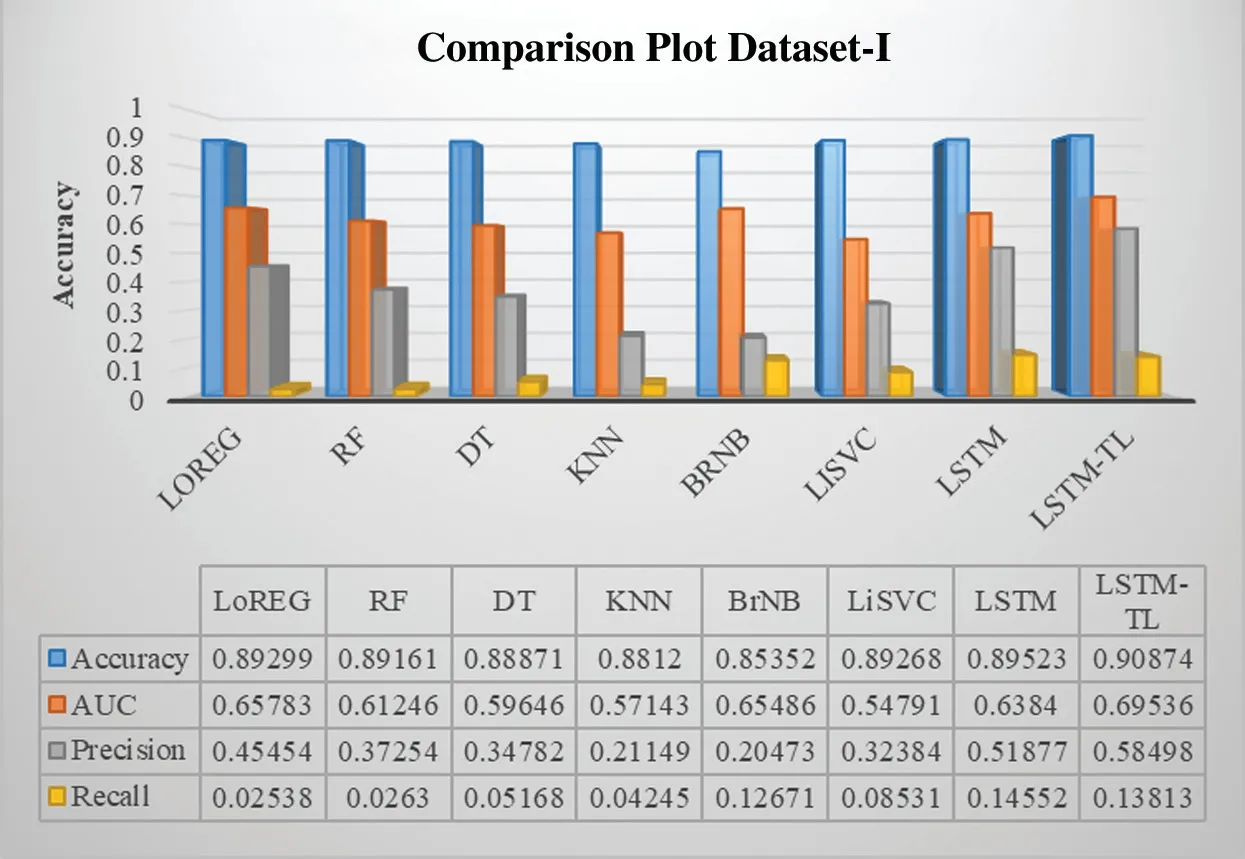
Figure 11:Performance comparison of the classifiers of DM dataset-I
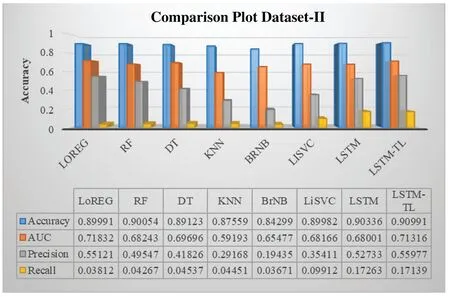
Figure 12:Performance comparison of the classifiers of renal disease dataset-II
4.3 Discussion
In this study,a DL framework is proposed to assess noisy,challenging,and incomplete data through high-end optimization and diabetes patients’ evaluation.To objective our study,the data is cleaned and transformed autonomously by converting the string into numeric,categorizing fields as per their relevancy,remove data scarcity,filling empty cells,and molding medication dosage.The autonomous method is an innovative dataset experiment to improve the HPM of the proposed DL model with minimal effort.An expert level scenario is also constructed in consultation with medical specialists and endocrinologists to achieve the research objective.The dose/level of the administered medicine is classified to distinguish between normal and diabetic patients.An algorithm is designed to leverage diabetic patient data to indicate their condition and predict their future status.The objective is to develop an RNN based LSTM model to train,validate,and test data with an in-depth exploration of dynamic changes to predict BG levels.We tried to normalize the scarce dataset and equated the readings through SEG,a modern metric,for clinical risk assessments.The BG errors give the data a unique risk score compared with a reference value,which helps evaluate the risk facing by diabetic patients by successfully categorizing the samples in the specified risk zones.We hope that the obtained results will improve the clinical accuracy and further experiments,such as data points falling into custom-defined risk zones.
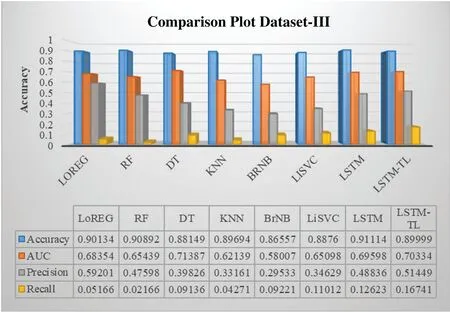
Figure 13:Performance comparison of the classifiers of cardiovascular disease dataset-III
Previous studies concentrate on predicting BG levels,diabetic/non-diabetic status,artificial pancreas readings,glycemic control,and physiological prototypical.Keeping in view,the results of the proposed model are initially tested with state-of-the-art ML baseline models,including logistic regression,random forest,decision tree,k-nearest neighbors,naïve bayes,and linear support vector classifier.All the baseline models reveal a good and constant accuracy around 89% except for the bernoulli naïve bayes (85%),which is also an encouraging result.The overall objective is to develop a method that can guide diabetic patients to choose their healthy lifestyle according to their diabetic condition.Nutritious food and physical activity are essential elements of a healthy lifestyle.However,it is optimistic about changing lifestyles drastically,but changes come steadily.
4.4 Transfer Learning
The numerical results show that integrating TL provides better predictive accuracy,particularly when the available dataset is noisy and incomplete.It reveals significant findings in sparse data with complex trends,missing and imputed values.Before training,data is normalized and optimized to create the TL dataset to pre-train a global LSTM model.The regulated data is trained to the RNN-LSTM DL model and tested to 20% of a dataset,which is always a reasonable percentage between maintaining model accuracy and avoiding overfitting.Here,our LSTM layer(s) did all the work to transform the input to predict the desired output.
5 Conclusion
To conclude,DL systems need data to provide difficult interpretations to effectively diagnose health conditions to improve clinical decision-making uncertainty.In this paper,the RNN-LSTM model is proposed to test and forecast diabetic patients’ disease status from the demanding realworld challenging dataset with scarcity,missing/imbalanced values,incomplete,and noisy data.The data is normalized autonomously via standard procedures and value mapping.The normalized data is fine-tuned by Bayesian optimization to chalk out interstitial HPM values.The data normalization,HPM tuning,and medicinal categorizing are customized according to the proposed model,which through state of the art ML and DL methods,provide a high and consistent level of accuracy.
An algorithm specifies the primary dataset with twenty-three medicinal attributes for a dosebased patient prediction.LSTM configuration is effectively optimized for accurate input,LSTM units,and output synchronization via trial and error basis.Finally,TL is integrated into LSTM to repair imbalances and feed-forward the training data for stable prediction and higher accuracy.To validate the model’s performance,two secondary datasets are tested to ensure model consistency,reliability,and accurate performance.
5.1 Future Work
The initial idea was to obtain a local dataset from the health regulatory bodies,hospitals,and laboratories for this research.However,the current COVID-19 emergency led us to use a readymade dataset for testing our proposed model.In a pilot investigation,we find that this work has significant implications for future research using a local dataset.In the future,we will collect data from local sources and prepare a pilot project by embedding sensor technology such as body area networks and generate a dataset.A complete framework will collect health data through customized software.The collected data will be normalized for accurate forecasting and bind aggregated readings with medical professionals for on-site expert advice.
5.2 Research Limitations
1.Increasing LSTM units leads to more complexity,processing time,and operating cost
2.Old datasets.Whereas dataset-I has missing fields of Age and Weight
3.Low test precessions
Funding Statement:This work is supported by Researchers Supporting Project number (RSP-2020/87),King Saud University,Riyadh,Saudi Arabia.
Conflicts of Interest:The authors declare that they have no conflicts of interest to report regarding the present study.
杂志排行
Computers Materials&Continua的其它文章
- Industrial Food Quality Analysis Using New k-Nearest-Neighbour methods
- Economical Requirements Elicitation Techniques During COVID-19:A Systematic Literature Review
- A Resource Management Algorithm for Virtual Machine Migration in Vehicular Cloud Computing
- Coronavirus:A“Mild”Virus Turned Deadly Infection
- Improved Channel Reciprocity for Secure Communication in Next Generation Wireless Systems
- Statistical Medical Pattern Recognition for Body Composition Data Using Bioelectrical Impedance Analyzer
